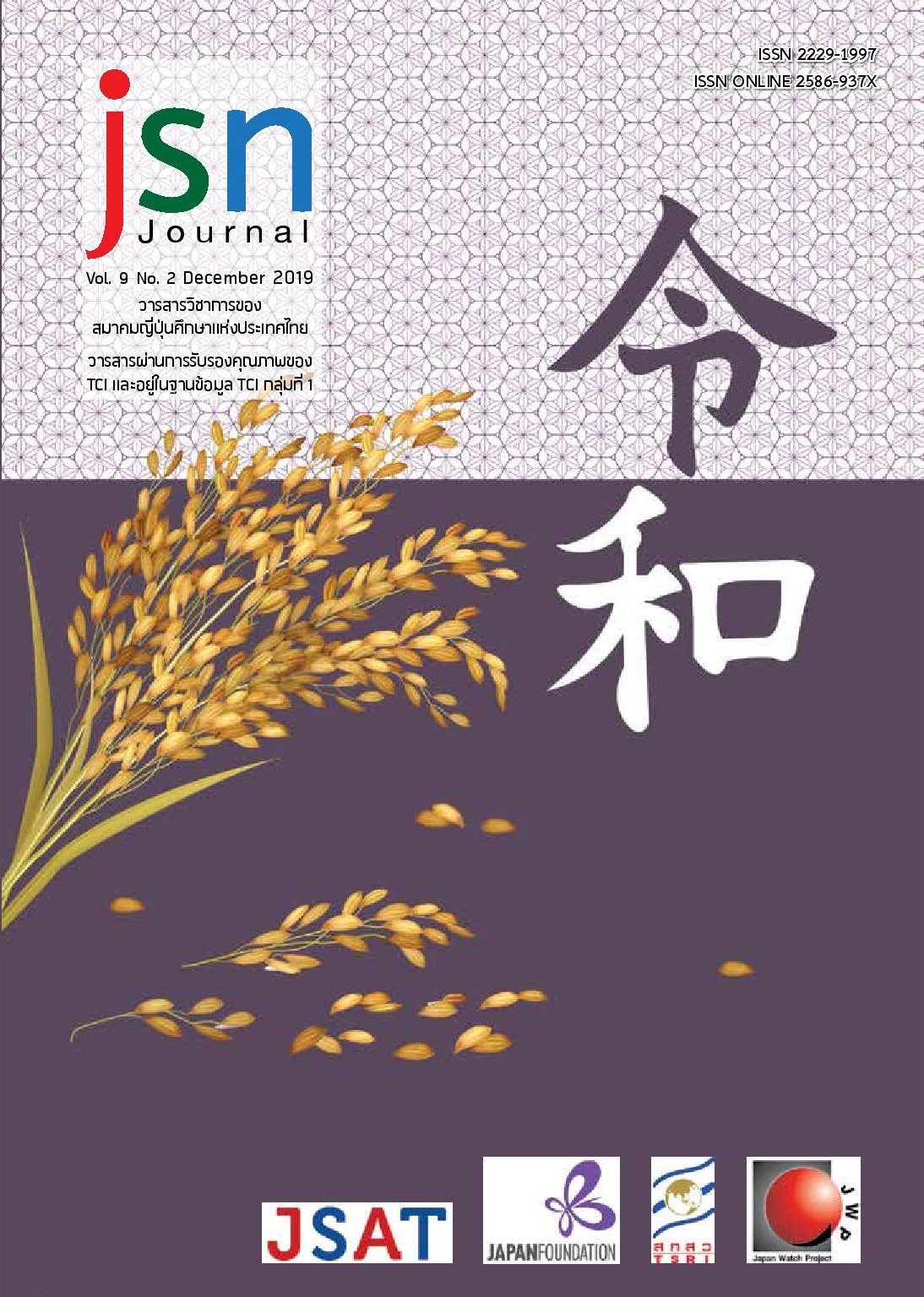Non-human Beings and Cultural Studies in Japanese Manga
Main Article Content
Abstract
The study “Non-human Beings and Cultural Studies in Japanese Manga” aims to analyze 3 Japanese Manga which present non-human being characters Tokyo Ghoul, Parasyte and Attack on Titan. This study reveals that these popular manga share similarity in presenting non-human being characters such as Ghoul, Parasyte and Titan. With cultural study methodology it shows that the creation of hybrid non-human beings and cannibalism cause exotism and their popularity. Meanwhile it arouses human’s fearfulness from the thought of human’s being threatened by otherness. Besides the uncanniness of these non-human beings provides philosophical questions to human beings about humanity and human’s positioning themselves as the top of the food chain in order to re-examine themselves and establish environmental and ecological consciences among them.
Article Details
ข้อความและข้อคิดเห็นต่างๆ ในบทความเป็นของผู้เขียนบทความนั้นๆ ไม่ใช่ความเห็นของกองบรรณาธิการหรือของวารสาร jsn Journal
References
ชวรินทร์ ศิลปะสุวรรณ. (2558). การเรียนรู้ของเยาวชนไทยเกี่ยวกับวัฒนธรรมญี่ปุ่นผ่านสื่อการ์ตูนญี่ปุ่น. มหาวิทยาลัยกรุงเทพ.
ชาญศักดิ์ พบลาภ. (2556). การศึกษารูปแบบตัวการ์ตูนแบบพื้นฐานญี่ปุ่นและแบบพื้นฐานอเมริกา เพื่อการออกแบบหนังสือประกอบการเรียน สำหรับนักเรียนโรงเรียนสาธิตแห่งมหาวิทยาลัย เกษตรศาสตร์วิยาเขตกำแพงแสน. Veridial E-Journal, SU, 6(1), 536-547.
ซุย อิชิดะ. อิศรา อุดมพาฌิชย์ (แปล). (2558). โตเกียว กูล. กรุงเทพฯ: สยามอินเตอร์คอมมิกส์.
เธียรทศ ประพฤติชอบ. (2558). “การ์ตูน” สื่อที่น่าจับตา มาพร้อมมูลค่าที่น่าจับใจ. วารสารการสื่อสารและการจัดการ นิด้า, 1(1), 1-13.
นฤพนธ์ ด้วงวิเศษ. (2561). มนุษย์กินคน คนกินเนื้อมนุษย์ (Cannibalism). ศิลปวัฒนธรรม, 1-2.
บารนี บุญทรง. (2547). บทบาทและหน้าที่ของผู้หญิงทำงานในสังคมญี่ปุ่นตั้งแต่หลังสงครามโลกครั้งที่สอง. วารสารศิลปศาสตร์ คณะศิลปศาสตร์ มหาวิทยาลัยธรรมศาสตร์, 4(2), 41-63.
ปิยะนุช วิริเยนะวัตร์. (2549). ภาพผู้หญิงญี่ปุ่นที่สะท้อนในงานเขียนสมัยเมจิ. วารสารศิลปศาสตร์ คณะศิลปศาสตร์ มหาวิทยาลัยธรรมศาสตร์, 6(1), 196-228.
วาสนา ปานนวม. (2555). การส่งเสริมการ์ตูนญี่ปุ่น เครื่องมือ Soft Power และผลประโยชน์ทางเศรษฐกิจ. วารสารญี่ปุ่นศึกษา, 29(1), 76-85.
วิมลณัฐ หวังสิทธิกุล. (2560). BL กับ มุมมองเพศสภาวะ (Gender): “ภาพสะท้อนผ่านสื่อท่ามกลางความเปลี่ยนแปลงในบริบทสังคมญี่ปุ่น. วารสารวิชาการมหาวิทยาลัยอีสเทิร์นเอเชีย ฉบับสังคมศาสตร์และมนุษยศาสตร์, 7(1), 70-77.
ศรีเรือน แก้วกังกวาน. (2551). ทฤษฎีจิตวิทยาบุคลิกภาพ (รู้เขา รู้เรา). สมุทรสาคร: บริษัทสำนักพิมพ์หมอชาวบ้าน จำกัด.
ฮาจิเมะ อิซายามะ. ประสิทธิ์ (แปล). (2553). ผ่าพิภพไททัน. กรุงเทพฯ: วิบูลย์กิจการพิมพ์.
ฮิโตชิ อิวาอากิ. SPRANT (แปล). (2554). ปรสิต. กรุงเทพฯ: สยามอินเตอร์คอมมิกส์.
Arens William. (1979). The Man-Eating Myth: Anthropology and Anthropophagy. US: Oxford University Press.
Clarke C. Arthur. (2010). 2001: A Space Odyssey. US: New American Library.
Deborah Shamoon and Chris McMorran. (2016). Teaching Japanese Popular Culture. Michigan: The Association for Asian Studies, INC.
Easthope Antony. (1998). “HOMI BHABHA, HYBRIDITY AND IDENTITY, OR DERRIDA VERSUS LACAN.” Hungarian Journal of English and American Studies (HJEAS). Vol. 4, No. 1/2, THEORY AND CRITICISM [Part 1] (1998), 145-151.
Erika Fujiwara. (2010). An Analysis of Contemporary Manga Culture in Japan and Sweden with a study of the works of Naoki Urasawa. Lunds University.
Freud Sigmund. (2003). The Uncanny. US: Penguin Classics.
Marshall, Ian. (2005). New Connections in Ecocriticism. Interdisciplinary Literary Studies 7.1 Penn State UP, 1-4.
Murphy D. Patrick, (2009). Ecocritical Explorations in Literary and Cultural Studies Fences, Boundaries, and Fields. UK: Lexington Books.
Rand, E. J. (2013). “Critical queer rhetorics bites back”. Western Journal of Communication, 77(5), 533-537.
_________. (2014). Reclaiming Queer: Activist and Academic Rhetorics of Resistance. Tuscaloosa, AL: University of Alabama Press.
Staszak J.-F. (2009). “Other/Otherness.” Kitchin R. and Thrift N. (eds.), International Encyclopaedia of Human Geography, vol. 8, 43-47. Oxford: Elsevier Science & Technology.
Takeshi Matsui. (2009). The Diffusion of Foreign Cultural Products: The Case Analysis of Japanese Comics (Manga) Market in the US. Tokyo: Hitotsubashi University.
Todorov, T. (1994). On Human Diversity: Nationalism, Racism, and Exoticism in French Thought. Harvard: Harvard University Press.
William M. Tsutsui. (2010). Japanese Popular Culture and Globalization. Michigan: The Association for Asian Studies, INC.
Yep, G. A., Lovaas, K. E., & and Elia, J. (Eds.). (2003). Queer Theory and Communication: from Disciplining Queers to Queering the Discipline(s). Binghamton, NY: Hawthorne Press.

